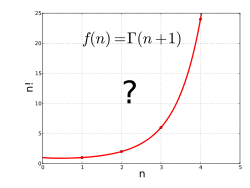A | B | C | D | E | F | G | H | CH | I | J | K | L | M | N | O | P | Q | R | S | T | U | V | W | X | Y | Z | 0 | 1 | 2 | 3 | 4 | 5 | 6 | 7 | 8 | 9
| Gamma | |
|---|---|
 The gamma function along part of the real axis | |
| General information | |
| General definition | |
| Fields of application | Calculus, mathematical analysis, statistics, physics |
In mathematics, the gamma function (represented by Γ, the capital letter gamma from the Greek alphabet) is one commonly used extension of the factorial function to complex numbers. The gamma function is defined for all complex numbers except the non-positive integers. For every positive integer n,
Derived by Daniel Bernoulli, for complex numbers with a positive real part, the gamma function is defined via a convergent improper integral:
The gamma function then is defined as the analytic continuation of this integral function to a meromorphic function that is holomorphic in the whole complex plane except zero and the negative integers, where the function has simple poles.
The gamma function has no zeroes, so the reciprocal gamma function 1/Γ(z) is an entire function. In fact, the gamma function corresponds to the Mellin transform of the negative exponential function:
Other extensions of the factorial function do exist, but the gamma function is the most popular and useful. It is a component in various probability-distribution functions, and as such it is applicable in the fields of probability and statistics, as well as combinatorics.
Motivation
The gamma function can be seen as a solution to the following interpolation problem:
- "Find a smooth curve that connects the points (x, y) given by y = (x − 1)! at the positive integer values for x."
A plot of the first few factorials makes clear that such a curve can be drawn, but it would be preferable to have a formula that precisely describes the curve, in which the number of operations does not depend on the size of x. The simple formula for the factorial, x! = 1 × 2 × ⋯ × x, cannot be used directly for non-integer values of x since it is only valid when x is a natural number (or positive integer). There are, relatively speaking, no such simple solutions for factorials; no finite combination of sums, products, powers, exponential functions, or logarithms will suffice to express x!; but it is possible to find a general formula for factorials using tools such as integrals and limits from calculus. A good solution to this is the gamma function.[1]
There are infinitely many continuous extensions of the factorial to non-integers: infinitely many curves can be drawn through any set of isolated points. The gamma function is the most useful solution in practice, being analytic (except at the non-positive integers), and it can be defined in several equivalent ways. However, it is not the only analytic function which extends the factorial, as adding to it any analytic function which is zero on the positive integers, such as k sin mπx for an integer m, will give another function with that property.[1]
A more restrictive property than satisfying the above interpolation is to satisfy the recurrence relation defining a translated version of the factorial function,[2][3]
for any positive real number x. But this would allow for multiplication by any function g(x) satisfying both g(x) = g(x+1) for all real numbers x and g(0) = 1, such as the function g(x) = e k sin 2mπx. One of several ways to finally resolve the ambiguity comes from the Bohr–Mollerup theorem. It states that when the condition that f be logarithmically convex (or "super-convex,"[4] meaning that is convex) is added, it uniquely determines f for positive, real inputs. From there, the gamma function can be extended to all real and complex values (except the negative integers and zero) by using the unique analytic continuation of f.[5]
Definition
Main definition
The notation is due to Legendre.[1] If the real part of the complex number z is strictly positive (), then the integral
converges absolutely, and is known as the Euler integral of the second kind. (Euler's integral of the first kind is the beta function.[1]) Using integration by parts, one sees that:
Recognizing that as
We can calculate :
Given that and
for all positive integers n. This can be seen as an example of proof by induction.
The identity can be used (or, yielding the same result, analytic continuation can be used) to uniquely extend the integral formulation for to a meromorphic function defined for all complex numbers z, except integers less than or equal to zero.[1] It is this extended version that is commonly referred to as the gamma function.[1]
Alternative definitions
Euler's definition as an infinite product
When seeking to approximate for a complex number , it is effective to first compute for some large integer . Use that to approximate a value for , and then use the recursion relation backwards times, to unwind it to an approximation for .[clarification needed] Furthermore, this approximation is exact in the limit as goes to infinity.
Specifically, for a fixed integer , it is the case that
If is not an integer then it is not possible to say whether this equation is true because we have not yet (in this section) defined the factorial function for non-integers. However, we do get a unique extension of the factorial function to the non-integers by insisting that this equation continue to hold when the arbitrary integer is replaced by an arbitrary complex number .
Multiplying both sides by gives
Text je dostupný za podmienok Creative
Commons Attribution/Share-Alike License 3.0 Unported; prípadne za ďalších
podmienok.
Podrobnejšie informácie nájdete na stránke Podmienky
použitia.
































